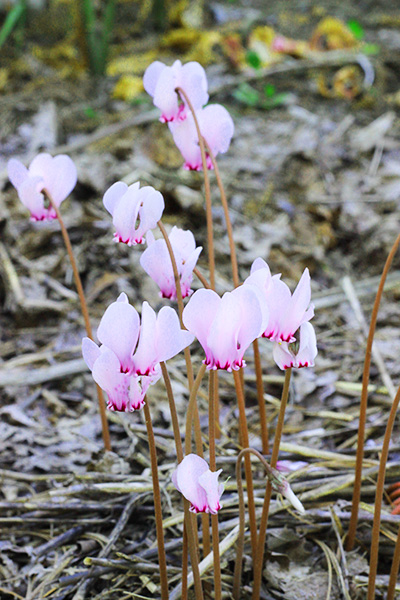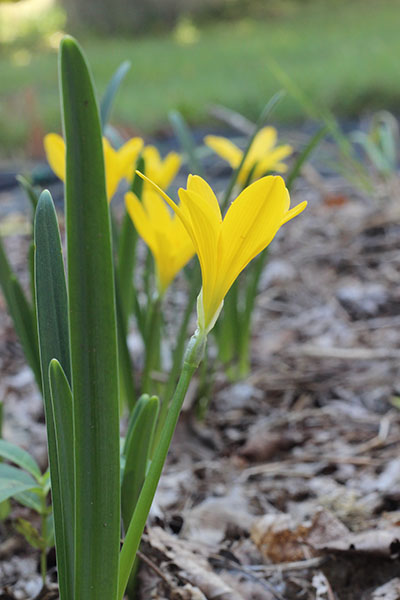Our Sternbergia and cyclamen have just started blooming this week, reminding us of the varieties that - though planted in the fall - don’t bloom in spring like daffodils or tulips and may arrive in active growth and benefit from being planted as soon as possible. For all of these, we recommend planting in their own section of the garden, and marking their places well, so that they won’t be hidden by other plants or have something else planted on top of them.
Purple-headed garlic (or drumstick allium) blooms in summer - July here - extending the allium season long past its spring/early-summer extravaganza. Their slender stems and leaves work their way through neighboring plants bringing their cheerful bursts of purple. They’ll naturalize over time, and - like other allium – animals tend to leave them alone.
Cyclamen may have leaves when it arrives, or may not put out any its first fall, so marking it is especially important: the first sign of it you may see are the delicate flowers emerging the following fall. Here in Michigan they tend to bloom just as the first leaves are falling, so keep an eye out for them so that they don’t get buried in leaves. Their foliage will emerge after they bloom.
Lycoris radiata, red spider lilies, put up leaves in their first fall, but resent transplanting (unless it’s from one neighbor’s yard to another) and may not bloom till their second fall. Since their foliage dies back in early summer, first-time growers are often worried that the bulbs have died, but they’re going through their normal summer dormancy. Please be patient, though they are slow to begin flowering, once established they will multiply. with more bursting through the tired remains of summer each year.
Similarly, surprise lilies (Lycoris squamigera) will send up foliage in the spring and then have a period of dormancy of 6-10 weeks followed by the “surprise” appearance of lavender-pink flowers seemingly out of nowhere, leading to their other names: magic lilies, resurrection lilies, and naked ladies. Like Lycoris radiata, they’ll return well in following years given sunshine and relatively dry summers.
Oxblood lilies (Rhodophiala) will arrive with leaves or send them up soon after planting but then won’t bloom till late summer (or even later). Your patience will be rewarded in future years: as our friend Greg Grant of Texas wrote in Country Living Gardener, oxblood lily is “easy and adaptable [and] thrives in any type of soil, with any pH, and any exposure. Moreover, it never needs dividing, never needs extra water, and has no insect pests. Its only two requirements are a dry summer and not removing its foliage before it goes dormant naturally” in late spring.
And returning once more to sternbergia, plant them upon arrival so they can get their leaves up for the fall and water them moderately. Since their foliage stays green through winter, it’s a good idea to cover them with a light, airy mulch of straw if your winters are harsh. They prefer to be kept fairly dry in the spring and early summer, and, left undisturbed, will multiply over time and bring golden accents to the early days of autumn.
You’ll find these, along with other lesser-known plants that follow a more traditional spring-blooming schedule, amongst our Diverse Fall bulbs. Why not give some a try this fall? You’ll be rewarded in years to come!















